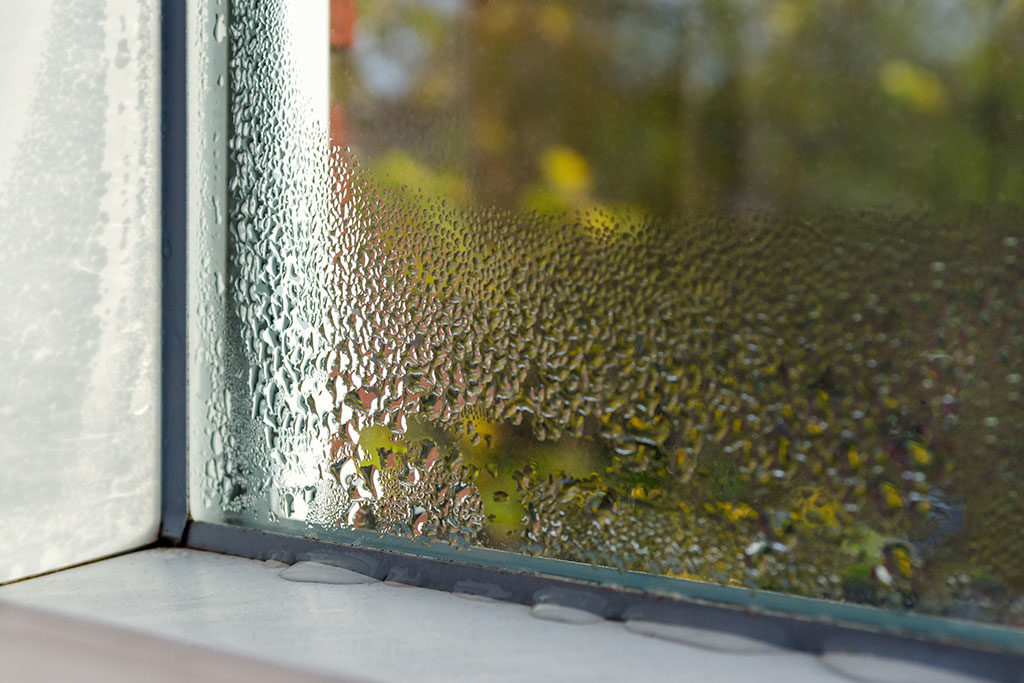Surprising Ways to Reduce Humidity in Your Home
Posted on by WestAIR Heating & Cooling

If you’ve been noticing foggy windows, musty odors, or clammy air throughout your home, chances are, your humidity levels are high. Humidity can both rob you of comfort and threaten your health. We don’t want you to suffer through the stifling heat, so we’ve outlined some surprising ways to reduce humidity in your home.
But first, a word about relative humidity (RH): RH measures water vapor relative to the temperature of the air. RH illustrates the amount of water in the air in relation to the total amount of humidity that could be held at the current temperature. Weather forecasts report relative humidity because it affects how we feel the temperature. Humid air feels warmer; dry air feels cooler. The ideal indoor relative humidity for a home is between 40 and 60 percent. If your RH is lower or higher, follow these tips:
Go old school with laundry
Dry your clothing outside. If you hang wet clothing inside to dry, all the moisture will evaporate into the air.
Accessorize with plants
Invest in some household tropical plants like Boston ferns, English ivies, Peace lilies, Reed Palms, or Tillandsias. These plants absorb moisture from the air instead of through the roots.
Take cold(er) showers
Hot showers create steam. Plan to bathe after exercising or spending time outside in the heat. You’ll be less tempted to jump into a steaming shower, and the cool water will feel refreshing. If nothing else, run the exhaust fan during and after showering.
Eat more salads
Hot weather provides the perfect opportunity to cook outside on the grill or eat cold meals like salads and sandwiches. Avoid boiling water; instead, save the heavy pasta for cooler weather. Your body will thank you in more ways than one.
Check the drainage route
In high humidity, your air conditioner or dehumidifier will produce a lot of condensation that has to go somewhere. Regularly empty the drip pan and be sure the drain lines are working properly so the water doesn’t evaporate back into the air.
Replace your flooring
Carpet is known to retain moisture. If you’ve tried all the above methods to decrease humidity, but still have a problem with moisture, consider replacing the carpet with hardwood flooring.
Benefits of proper humidity
With lower humidity levels, you could raise the thermostat setting a few degrees and still be comfortable. High humidity may cause headaches and asthma symptoms such as wheezing, shortness of breath, or a chronic cough. Proper humidity levels are easier on your respiratory tract and can:
- Reduce your cooling costs.
- Minimize wear on your HVAC system.
- Prevent dust mites, mold, bacteria, and mildew.
- Eliminate foul odors.
- Help you sleep better.
If you are still having trouble, consult with the professionals at WestAIR Heating & Cooling. We offer high-efficiency air conditioners to keep you cool in the muggy season and countless air quality accessories to reduce humidity. Schedule service to have a technician visit your home and recommend the right solutions for your family’s total indoor air comfort.
Contact us for more information.
This entry was posted in Air Conditioning,Cooling,Health Tips,Indoor Air Quality,Tips and tagged Air quality accessories, Asthma, Comfortable, Cooling, Dehumidifier, Energy efficiency, Energy savings, Grilling out, Humidity, HVAC, HVAC tips, Indoor air, Indoor air quality, Indoor air quality solutions, Muggy season
Indoor Air Quality Solutions
Posted on by WestAIR Heating & Cooling

Ever looked at a ray of light streaming through your windows and noticed floating dust particles? The sunlight can reveal a lot about a room’s air quality. While it may be tempting to open up the windows and doors for a quick fix, we’re in the thick of ragweed season, so it probably won’t do you any favors. The EPA recommends upgrading your HVAC filter or using an air cleaner to reduce harmful airborne particles. Read our blog to learn why and discover some more indoor air quality solutions.
New filters
Your HVAC filter traps microorganisms, animal fur, hair, lint, dander, mold, pollen, dirt, and more so they don’t accumulate in your system or irritate your lungs. Check your filter once a month to see if it needs replacing. A clogged air filter can cause your HVAC equipment to overheat, short cycle, or even break down. At the very least, changing a dirty filter could lower your energy bills because your system won’t have to work twice as hard just to obtain adequate airflow.
Air cleaner
An air cleaner uses a filter to trap particles like bacteria, mold, ragweed, pet dander, and dust mites. It can even eliminate viruses, kill germs, neutralize fumes, and remove odors. Those with allergies, asthma, or sensitivity to chemicals can benefit from an air cleaner, which can remove up to 97 percent of pollen-sized particles.
Air exchanger
Every time you cook, shower, clean, and breathe, you release pollutants into the air. Airtight buildings are more energy efficient, but they need to somehow circulate air to maintain a healthy environment. Without adequate ventilation, old air will sit in enclosed spaces and accumulate dust, bacteria, mold, and other harmful particles.
An air exchanger provides refreshed, filtered air to reduce these allergens. Air exchangers use two fans, one to take stale air out, and the other to pull in fresh air, run it through a filter, and disperse it through the ductwork.
Dehumidifier
Humidity makes a room seem hotter than it is and increases the likelihood of mold and mildew growth. Drier air feels cooler. A dehumidifier can increase your comfort and allow you to raise the temperature a few degrees to save on cooling expenses. You can use a portable unit or install a whole house dehumidifier that works in conjunction with your HVAC system.
Dehumidifiers pull moist air over a cooling coil that condenses the moisture vapor into droplets. Moisture along the coils drips into a collection pan or directly down a drain.
Duct cleaning
In most HVAC systems, all the conditioned air passes through ductwork to supply vents in each room, and back through return registers to be conditioned again. Particles floating in the air could become trapped in the many channels and crevices behind your walls. If the ductwork is dirty, your indoor air will be, too, no matter what air cleaning accessories you install. During air duct cleaning, your technician will use powerful vacuums and brushes to dislodge debris and allow proper airflow.
Bonus tip
Plants clean the air of carbon dioxide and can remove cancer-causing formaldehyde, benzene, and other toxins. If you are looking for an inexpensive way to purify your indoor air, bring in some potted vegetation. They can improve your physical health as well as your mental well-being by reducing stress, building memory retention, and increasing concentration, which in turn boosts productivity.
At WestAIR, we care about you and your family’s health and comfort. We offer air quality solutions to rid your home or business of harmful pollutants and provide fresh oxygen, day in, and day out.
Contact us to learn more.
This entry was posted in Duct Cleaning,Indoor Air Quality,Tips and tagged Air circulation, Air cleaner, Air filters, Allergies, Asthma, Clean HVAC ducts, Comfortable, Cooling, Energy efficiency, Energy savings, Humidity, HVAC, HVAC tips, Indoor air quality, Indoor air quality solutions
Spring HVAC Checklist
Posted on by WestAIR Heating & Cooling

Some of the most pressing concerns for Minnesota homeowners are humidity levels, poor air quality, and increased utility bills. In the spring, those HVAC issues are a hot topic as the warm weather approaches. Follow our spring HVAC checklist to inspect and prepare your equipment for summer.
- Turn off power to your outdoor unit from the electrical disconnect and clear away plants, weeds, fallen leaves, and branches. Use a garden hose to gently rinse off the condenser coils. If the unit doesn’t get enough air or the coils are covered in dirt, it could overheat.
- Change your filter, and plan to do so monthly when your furnace and air conditioning are in use. Filters keep dust and dirt from entering your system, extend equipment life, reduce energy costs, and improve indoor air quality.
- Clean return air vents and floor registers in your home with a vacuum. If dust gets in the system, it could compromise energy efficiency and air quality. For a deeper clean, remove the vent, wrap a butter knife in a rag to scrub the individual grill spaces, and rinse with warm water and soap.
- Check the batteries in your carbon monoxide detector(s) and replace if needed so you know it is working properly to keep your family safe.
- Caulk windows and doors to minimize air leakage so the cool air your system produces isn’t wasted. According to the U.S. Department of Energy, the best time to apply caulk is in low humidity when the temperature is about 45 degrees, making spring the ideal time for this simple maintenance.
- Dust and mop so dirt, allergens, and other airborne particles don’t end up in your ductwork. Schedule duct cleaning if you haven’t done so in a while or you suspect your ductwork is dirty.
- Clean windows, blinds, and curtains so you can let the sunlight into your home and enjoy a clear view of the outdoors without producing a cloud of dust each time you open them.
- Dust ceiling fan blades and reverse their direction to rotate counterclockwise so they’ll blow air straight down and produce a wind-chill effect. Most fan models have a small switch on the motor housing.
- Power up your air conditioning to see if everything is working properly. You should visually inspect the unit for any leaking chemical fluids and check your home for burning, gas, or musty odors.
- Schedule service with your HVAC contractor for a thorough inspection. They’ll clean, lubricate, and troubleshoot your equipment so it will run smoothly and efficiently.
Midwest summers can be particularly hot and sticky, and homeowners can spend up to 250 dollars a month running their air conditioner. WestAIR Heating & Cooling is here to help you save money in every season with a variety of specials on our services. We also provide indoor air quality solutions so you can minimize spring allergies and live comfortably. If you are having trouble with your HVAC system, contact us for repair and replacement services.
This entry was posted in Air Conditioning,Duct Cleaning,Indoor Air Quality,Repairs,Spring and tagged A/C, air conditioning, Allergies, Asthma, Clean HVAC ducts, Cooling, Duct cleaning, Dust, Energy savings, Hot weather, Humidity, HVAC, HVAC checklist, Indoor air, Indoor air quality, Indoor air quality solutions, Indoor humidity
How to Improve Indoor Air Quality
Posted on by WestAIR Heating & Cooling
 In some cities, air pollution and smog create major health concerns. But the air inside of your home could contain more contaminates no matter where you live. Changing your living habits and investing in superior equipment will make major improvements to your indoor air quality.
In some cities, air pollution and smog create major health concerns. But the air inside of your home could contain more contaminates no matter where you live. Changing your living habits and investing in superior equipment will make major improvements to your indoor air quality.
Cleaning
If your home contains carpet, use a high-quality vacuum with a HEPA filter to reduce household dust, pet dander, and chemicals. Experts recommend vacuuming at least two times a week. For homes without carpet, sweeping and mopping effectively captures dirt and pollutants. Dry microfiber mops successfully grab dust and allergens as well but don’t require any chemical cleaners. Putting extra care into your cleaning routine will not only improve the look of your home but also the air quality. Think of all the chemicals, fecal matter, and allergens that cling to your shoes or clothing when you enter a building. Taking your shoes off or using a large matt to wipe your shoes can help reduce pollutants as well.
Reducing Toxicity
One of the worst culprits of compromised indoor air quality is cigarette smoke. The smoke contains more than 4,000 chemicals and can increase the risk of asthma, lung cancer, and stroke. Radon poses as another risk for lung cancer, especially in the Midwest where the gas concentrations are high. Radon gas comes from the natural decay of uranium in the ground and leaks through your home’s foundation. Call a professional if your house has not been tested for radon. Toxic particles can come from the products you use to clean, too. Fragrance and household chemicals emit VOCs (Volatile Organic Compounds). You can find VOCs in higher concentrations indoors, and they come with serious health risks. Reduce these chemicals by switching to natural or mild soaps or cleaners. Essential oils, vinegar, and baking soda can become effective DYI cleaners, too.
Air Support
Adding plants like dracaena, peace lilies, and spider plants improve indoor air quality and attractiveness inside your home. Air purifiers or air cleaners are even more effective at creating fresh and clean air. An air cleaner can capture 98% of airborne particles circulating through your home. We recommend these heating and cooling add-ons for people with asthma, allergies, or chronic illnesses. Depending on the MERV or HEPA rating, filters capture dust, pollen, mold, pet dander, pollutants, viruses and bacteria in the air. Dust mites and mold also thrive in moisture, so investing in an air exchanger or dehumidifier to use in the summer months will help as well. If your house smells musty or already shows signs of mold, you should invest in a dehumidifier.
Would you like better indoor air quality?
Contact WestAIR Heating and Cooling for more information on dehumidifiers and air cleaners.
This entry was posted in Indoor Air Quality and tagged Air cleaner, Air purifier, Allergies, Asthma, Bacteria, Breathe better, Cancer, Chemicals, Cigarettes, Clean air, Cleaning, Dehumidifier, Dust, Fragrance, HEPA, Home purifier, MERV, Mold, Natural alternatives, Pet dangers, Plants, Radon, Smoking, Toxic, Vacuum, Viruses, VOCs
How to Reduce Indoor Humidity
Posted on by WestAIR Heating & Cooling
 In the Midwest, we feel the weather to the extremes – below zero and dry in the winter to 90+ degrees and humid in the summer. For those summer months, many of us cool our homes with some sort of air conditioning, but the humidity still sticks around the house. Extra moisture makes the air feel warmer and damages your walls, floors, furniture, and cabinets. You can effectively reduce indoor humidity with three different products, but which one will work best for you?
In the Midwest, we feel the weather to the extremes – below zero and dry in the winter to 90+ degrees and humid in the summer. For those summer months, many of us cool our homes with some sort of air conditioning, but the humidity still sticks around the house. Extra moisture makes the air feel warmer and damages your walls, floors, furniture, and cabinets. You can effectively reduce indoor humidity with three different products, but which one will work best for you?
Portable Dehumidifier
These units plug into any room and are suitable for homes with poor air circulation or no ventilation. Spaces like the basement, kitchen, or bathroom become susceptible to mold. Dishwashers, dryers, and showers add extra heat and moisture to your home. Portable dehumidifiers are the smartest solution for rooms that smell of must or feel damp and stale.
Whole House Dehumidifier
This system works best for old houses that use ductwork for heating and cooling. Older houses are prone to leaks and mold. If you often find condensation on your walls or you’ve had problems with mold before, you should consider a whole house dehumidifier. If you or a family member has asthma or chronic respiratory issues, humidity can aggravate your symptoms. Install a whole house dehumidifier to reduce moisture and improve your health.
Air Exchanger
An air exchanger has two channels of air flow, ventilating your home with fresh, filtered air. One channel pulls outside air into the home, while the other pushes stale air out. This exchange removes humid air or pollutants. The air exchanger works seamlessly with your heating & cooling equipment to improve air quality. If you own a newer home and want a constant supply of fresh air, consider adding an air exchanger to your HVAC system.
Contact WestAIR Heating and Cooling to learn more about reducing humidity, improving indoor air quality, and installing an air exchanger in your home.
This entry was posted in AC,Air Conditioning,Cooling,Energy Savings,Indoor Air Quality and tagged Air, Air cleaner, Air exchanger, Allergies, Asthma, Basement, Bathroom, Breath better, Condensation, Dehumidifier, Hot weather, Humid, Humidity, Indoor humidity, Kitchen, Mold, Portable dehumidifier, Summer, Toxic, Whole home dehumidifier
Subscribe to Our Blog
With RSS feeds, you don't have to visit our site everyday to keep up to date. Simply subscribe to our blog via RSS or Email and our posts will come to you!
Search Blog Posts
Categories
Archives
- April 2024 (1)
- February 2024 (1)
- January 2024 (1)
- February 2023 (1)
- January 2023 (1)
- December 2022 (1)
- November 2022 (1)
- October 2022 (1)
- September 2022 (1)
- August 2022 (1)
- July 2022 (1)
- June 2022 (1)
- May 2022 (1)
- April 2022 (1)
- March 2022 (1)
- February 2022 (2)
- December 2021 (1)
- November 2021 (1)
- October 2021 (1)
- September 2021 (1)
- August 2021 (1)
- July 2021 (1)
- June 2021 (1)
- May 2021 (1)
- April 2021 (1)
- March 2021 (2)
- January 2021 (1)
- December 2020 (1)
- November 2020 (1)
- October 2020 (1)
- September 2020 (1)
- August 2020 (1)
- July 2020 (1)
- June 2020 (1)
- May 2020 (1)
- April 2020 (1)
- March 2020 (1)
- February 2020 (2)
- November 2019 (1)
- August 2019 (2)
- June 2019 (1)
- May 2019 (1)
- April 2019 (1)
- March 2019 (1)
- February 2019 (1)
- January 2019 (1)
- December 2018 (1)
- November 2018 (1)
- October 2018 (1)
- September 2018 (1)
- August 2018 (2)
- July 2018 (1)
- May 2018 (1)
- April 2018 (1)
- March 2018 (1)
- February 2018 (1)
- January 2018 (1)
- December 2017 (3)
- November 2017 (2)
- October 2017 (2)
- September 2017 (2)
- August 2017 (1)
- July 2017 (2)
- June 2017 (3)
- May 2017 (2)
- January 2017 (4)
- November 2016 (1)
- September 2016 (3)
- July 2016 (2)
- June 2016 (2)
- May 2016 (4)
- April 2016 (1)
- March 2016 (2)
- February 2016 (2)
- January 2016 (1)
- August 2015 (1)
- July 2015 (1)
- June 2015 (3)
- May 2015 (1)
- July 2014 (2)
- June 2014 (1)
- April 2014 (1)
- March 2014 (1)
- February 2014 (2)
- October 2013 (1)
- May 2013 (1)
- March 2013 (1)
- February 2013 (1)
- August 2012 (1)
- July 2012 (2)
- June 2012 (2)
- May 2012 (2)
- March 2012 (1)
- February 2012 (1)
- December 2011 (1)
- November 2011 (1)
- October 2011 (1)
- September 2011 (1)
- August 2011 (1)
- June 2011 (1)
- May 2011 (1)
 Subscribe
Subscribe Subscribe
Subscribe